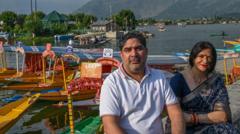Saudi authorities have scaled up their safety measures for the annual Hajj pilgrimage in Mecca, striving to protect the health and safety of the 1.4 million pilgrims in attendance, in light of last year's harrowing experiences that led to 1,300 deaths. To counter the forecasted blistering temperatures of up to 44°C (111°F), significant resources have been allocated, including the planting of thousands of trees and the installation of hundreds of cooling units around the holy sites.
The Ministry of Hajj has strictly enforced regulations to manage the influx of attendees, implementing fines and entry bans for unregistered pilgrims attempting to participate without proper permits. Already, authorities have intercepted more than 269,000 would-be entrants who did not meet registration requirements. It was noted that a staggering proportion of last year’s fatalities involved unregistered individuals who lacked access to essential amenities.
To ensure the well-being of pilgrims, the Saudi health ministry has provided specific advice to minimize their exposure to the sweltering heat, recommending the use of umbrellas, hydration, and avoiding sun exposure during peak hours. Enhancements have been made around the Grand Mosque, including a significant expansion of shaded areas and the deployment of over 400 cooling units, with the cooling system in the mosque being recognized as the largest in the world.
In addition, infrastructural improvements such as rubberized and temperature-reducing roads have been developed while artificial intelligence is being utilized to coordinate drone fleets for crowd management. As the pilgrims begin various religious rituals, including the tawaf and the trek to Mount Arafat, the efforts of Saudi authorities reflect a commitment to safeguarding their health while they fulfill one of the five pillars of Islam.
The Hajj is not only a spiritual journey but also a massive logistical operation, with past incidents—ranging from stampedes to health emergencies—emphasizing the importance of careful planning and safety measures to facilitate the pilgrimage experience.
The Ministry of Hajj has strictly enforced regulations to manage the influx of attendees, implementing fines and entry bans for unregistered pilgrims attempting to participate without proper permits. Already, authorities have intercepted more than 269,000 would-be entrants who did not meet registration requirements. It was noted that a staggering proportion of last year’s fatalities involved unregistered individuals who lacked access to essential amenities.
To ensure the well-being of pilgrims, the Saudi health ministry has provided specific advice to minimize their exposure to the sweltering heat, recommending the use of umbrellas, hydration, and avoiding sun exposure during peak hours. Enhancements have been made around the Grand Mosque, including a significant expansion of shaded areas and the deployment of over 400 cooling units, with the cooling system in the mosque being recognized as the largest in the world.
In addition, infrastructural improvements such as rubberized and temperature-reducing roads have been developed while artificial intelligence is being utilized to coordinate drone fleets for crowd management. As the pilgrims begin various religious rituals, including the tawaf and the trek to Mount Arafat, the efforts of Saudi authorities reflect a commitment to safeguarding their health while they fulfill one of the five pillars of Islam.
The Hajj is not only a spiritual journey but also a massive logistical operation, with past incidents—ranging from stampedes to health emergencies—emphasizing the importance of careful planning and safety measures to facilitate the pilgrimage experience.




















